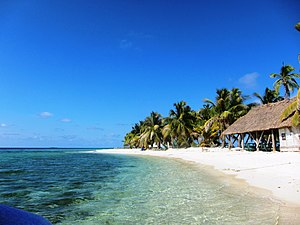Laughing Bird Caye
| Laughing Bird Caye | ||
|---|---|---|
| Laughing Bird Caye | ||
| Waters | Caribbean Sea | |
| Geographical location | 16 ° 28 '5 " N , 88 ° 11' 38" W | |
|
|
||
| length | 400 m | |
| width | 40 m | |
| surface | 0.7 ha | |
| Residents | uninhabited | |
Laughing Bird Caye is an island off the coast of Belize . It is one of the 450 islands of the Belize Barrier Reef . Administratively it belongs to the Stann Creek District .
geography
Laughing Bird Caye is the southernmost island of the central lagoon of the Belize Barrier Reef. The worm-shaped island is 18 kilometers east of Placencia on the western side of the Victoria Channel. The distance to the eastern barrier reef is about 14 kilometers. The island is over 400 meters long, but only a maximum of 40 meters wide. The subsoil consists of sand and gravel.
history
The island is named after the Aztec gull , which used to breed there and whose English name is laughing gull . Laughing Bird Caye has long been used by fishermen who fished around the island and processed their catch on the island in makeshift camps. In 1981 the island was declared a "protected area" and in 1991 a national park, which in addition to the island itself also includes 4.1 hectares of the surrounding sea area and is looked after by the Southern Environmental Association (SEA). Since then, fishing has not taken place within a mile of the island due to a legally non-binding voluntary commitment by the municipality of Placencia. Today the island can be visited from Placencia as part of day trips. Apart from a small visitor center and an open refuge with picnic benches, there is no infrastructure whatsoever.
Flora and fauna
The island offers protection to numerous species of birds. In addition to the Aztec gull , brown pelican , dive dives and green herons have also been spotted. Various types of lizards and insects also live on the island.
At plants that have spread to Laughing Bird Caye, there are coconut palm , morning glories , red mangrove , Spider Lily , Black Mangrove and Sesuvium portulacastrum . Rare deer and elk antler corals grow in the sea surrounding the island , which NGOs specifically reproduce by attaching artificial structures to the sea floor.
Illustrations
Web links
Individual evidence
- ↑ Travel report on NationalParksTraveler.com
- ↑ Fragments of Hope blog ( page no longer available , search in web archives ) Info: The link was automatically marked as defective. Please check the link according to the instructions and then remove this notice.




